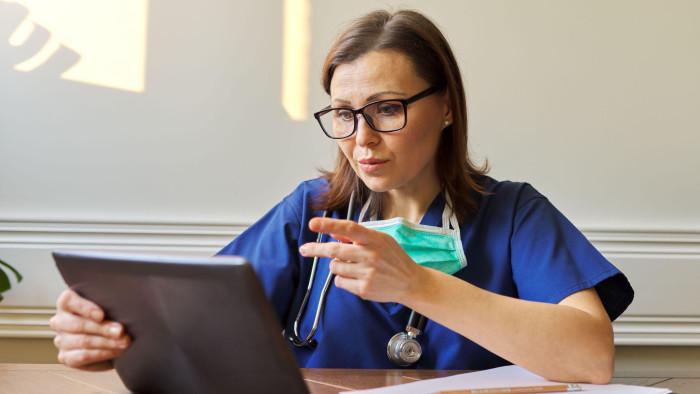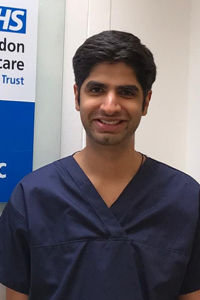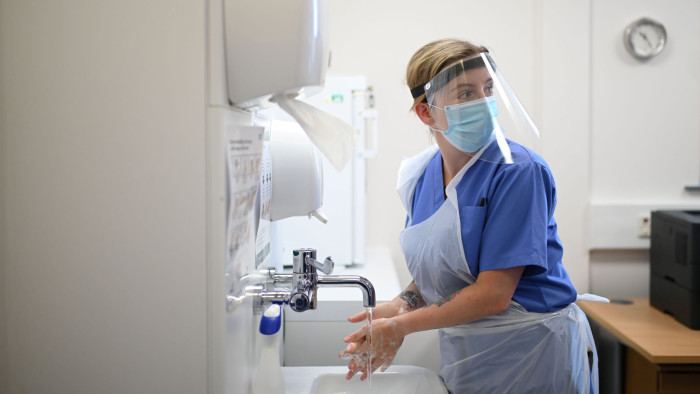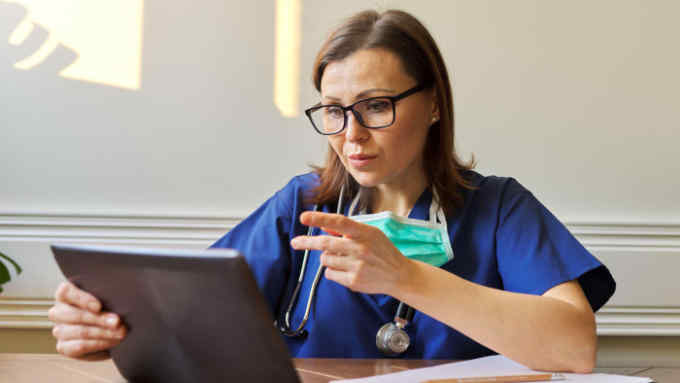Doctors add a dose of medical insight to FT coronavirus hackathon

Roula Khalaf, Editor of the FT, selects her favourite stories in this weekly newsletter.
Husain Khaki is a senior executive at a medical tech start-up, KroniKare, but as a trained doctor he returned to the NHS frontline during the pandemic to work at specialist coronavirus clinics — so-called “hot hubs” — across London.
On top of that, he was taking part in the FT’s legal hackathon, set up in April in response to Covid-19. Combining the two felt like “spinning many plates”, he says. Dr Khaki joined hackathon video calls from the clinics, or between patient visits, but his medical expertise made all the difference to his team.
“He would turn up late to the meeting dressed in his scrubs, and be very apologetic,” says Akber Datoo, founder and managing director of D2 Legal Technology, a legal data consulting firm. “It helped remind us about the context of all of this . . . to understand what ideas would work, what wouldn’t work and understand what the real challenge was.”
Their team, which focused on how to help buildings reopen after lockdown, was among a number where doctors and medical workers joined forces with lawyers, tech experts and other professionals, to find answers to health-related legal challenges.

The multidisciplinary teams worked online, often across several time zones, to develop solutions including a health-monitoring tool to help reopen public buildings and an app to facilitate the trade of personal protective equipment (PPE).
The pandemic had created urgent demand for healthcare and data technology.
“We have seen businesses [in all sectors] go quickly to operating remotely, with some challenges but working through them because there is the demand,” says Jodi Daniel, head of the digital health practice at law firm Crowell & Moring, headquartered in Washington DC. “The same is true in healthcare. The technology exists, we have the capability of doing secure video consultations, [of] getting diagnostic data from patients remotely.”
As more countries continue to lift lockdown restrictions, governments are banking on contact-tracing tools to help make public spaces and buildings safe.
“We’re all so desperate to create a future that’s workable, that preserves the good things about life as we’ve got used to them,” says Mr Datoo.
Mr Datoo’s team, comprising colleagues from D2, University of Surrey academics and KroniKare, worked on a health monitoring app called OUALD (“opening up after lockdown”) for use in buildings where many people normally crowd together, such as shopping centres or universities.
Using thermal imaging technology that KroniKare had already developed, the idea is to help people navigate busy spaces by raising an alert through the app when anyone in the vicinity shows symptoms.
The next step is to establish a protocol for how this data would be managed.
“Think about the shopping centre, it’s incredibly complex. You have the owners of the centre, owners of the different shops, the customers — there are a lot of terms and conditions that are going to have to flow to make this all work,” says Mr Datoo.
While Ms Daniel hopes that relaxations of policy and legal restrictions around health data collection will continue beyond the crisis, she says it is important not to lose sight of privacy and safety.
“If folks don't trust their data is being protected they may not share that data. I think we can do both,” she says.
Rebecca Karpin, a law graduate in the venture capital practice at law firm Squire Patton Boggs in Sydney, Australia led a hackathon team that included doctors, lawyers and students.
They reviewed some of the legal and health challenges that had been submitted to the hackathon, and ended up developing Medi Trade — a proposed app to enable trade of PPE by providing regulatory information to governments and medical companies.
“We realised all these different people were trying to access the masks, [and other] equipment,” says Ms Karpin.
As trade of PPE is international, the app must keep up with multiple country-specific regulations, which were changing daily during the hackathon. The team wants to get licences to be able to track changing regulations, and a developer is working on incorporating artificial intelligence into the app to update regulatory information automatically. Once the tool is ready, they will start approaching sponsors and investors.
To make the app as useful as possible, Ms Karpin and her team had to identify the typical user early on — someone who is procuring PPE — and understand their needs.
“That was where medical professionals were able to step in and say there are admin staff at the hospital who order in the PPE, but it would generally be a simple job,” she says. “We needed to make it a simple design, that someone who might be 50 years old and a senior manager in a hospital would be able to easily understand [without] IT services.”

The doctors were also able to give valuable context about PPE and share contacts who could provide more information.
For Ms Karpin, the hackathon was an opportunity to bring everyone together to work towards a common goal: “Fighting this virus requires everyone to be sharing data across borders and sharing resources, because we want a worldwide solution and it requires more of a collaborative approach.”
With appropriate safeguards, Ms Daniel says health organisations and professionals could share valuable information, and empower individuals to manage their own healthcare and data.
The combination of contact-tracing apps, use of tele-health tools, remote monitoring technology and greater accessibility of data could be transformative, she says. “I think we’re going to see a huge shift to where the patients have a lot of information they need to manage their own care, seek services they wish, share that information and use technology to make some of their own decisions.”

Comments